
- Home
- Frame Size
- Frame Thickness
- Item Height
- Item Length
- Item Width
- Type
- Canvas (20)
- Canvas Picture (7)
- Canvas Print (61)
- Comic Book (2)
- Engraving (4)
- Etching (3)
- Framed Print (3)
- Framed Prints (7)
- Lithograph (14)
- Photograph (3)
- Picture / Print (57)
- Poster (43)
- Print (1433)
- Prints (3)
- Skateboard (3)
- Stretcher Bars (2)
- T-shirt (3)
- Vintage Art Print (3)
- Wall Art (64)
- Wall Mirror (6)
- Other (3167)
Rare! Original Anni Albers Triadic Series F'69 Ivory White Signed Serigraph #32
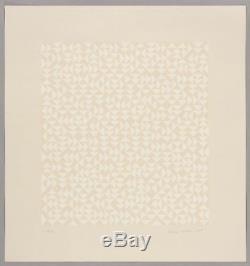
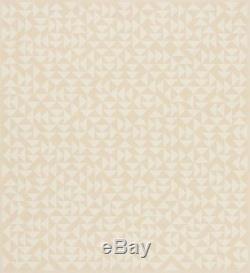
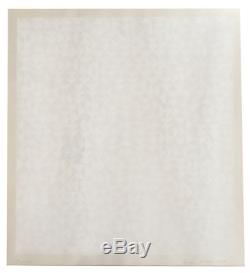
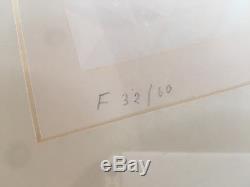
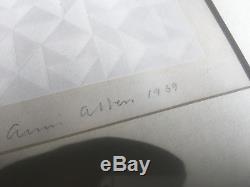


Triadic Series F Signed & Dated: Pencil (Bottom-Right) Numbered: 32/60 (Bottom-Left) (See Harvard Art Museum/Busch-Reisinger Museum Object BR72.1) Annelise Albers (née Fleischmann) (June 12, 1899 May 9, 1994) was a German textile artist and printmaker. She is perhaps the best known textile artist of the 20th century.
Albers was born Annelise Else Frieda Fleischmann in Berlin of Jewish descent. Her mother was from a family in the publishing industry and her father was a furniture maker. Even in her childhood, she was intrigued by art and the visual world.
She painted during her youth and studied under impressionist artist Martin Brandenburg, from 1916 to 1919, but was very discouraged from continuing after a meeting with artist Oskar Kokoschka, who upon seeing a portrait of hers asked her sharply Why do you paint? She eventually decided to attend art school, even though the challenges for art students were often great and the living conditions harsh. Such a lifestyle sharply contrasted the affluent and comfortable living that she had been used to. Albers attended the Kunstgewerbeschule in Hamburg for only two months in 1919, then in April 1922 began her studies at the Bauhaus at Weimar. At the Bauhaus she began her first year under Georg Muche and then Johannes Itten. Women were barred from certain disciplines taught at the school[verification needed] and during her second year, unable to get into a glass workshop with future husband Josef Albers, Anni Albers deferred reluctantly to weaving. With her instructor Gunta Stölzl, however, Albers soon learned to love weaving's tactile construction challenges. In 1925 Anni and Josef Albers, the latter having rapidly become a "Junior Master" at the Bauhaus, were married.The school moved to Dessau in 1926, and a new focus on production rather than craft at the Bauhaus prompted Albers to develop many functionally unique textiles combining properties of light reflection, sound absorption, durability, and minimized wrinkling and warping tendencies. She had several of her designs published and received contracts for wall hangings.
For a time Albers was a student of Paul Klee, and after Gropius left Dessau in 1928 Josef and Anni Albers moved into the teaching quarters next to both the Klees and the Kandinskys. During this time, the Albers began their lifelong habit of travelling extensively: first through Italy, Spain, and the Canary Islands. When Gunta Stölzl left the Bauhaus in 1931, Anni Albers took over her role as Head of the Weaving Workshop, making her one of the few women to hold such a senior role at the school. The Bauhaus at Dessau was closed in 1932 under pressure from the Nazi party and moved briefly to Berlin, permanently closing a year later in August 1933.Anni and Joseph Albers were invited by Philip Johnson to teach at the experimental Black Mountain College in North Carolina, arriving stateside in November 1933. Both taught at Black Mountain until 1949. During these years Anni Albers's design work, including weavings, were shown throughout the US. Albers wrote and published many articles on design. In 1949, Anni Albers became the first designer to have a one-person exhibition at the Museum of Modern Art in New York City.
Albers's design exhibition at MoMA began in the fall and then toured the US from 1951 until 1953, establishing her as one of the most important designers of the day. During these years, she also made many trips to Mexico and throughout the Americas, and became an avid collector of pre-Columbian artwork. After leaving Black Mountain in 1949, Anni moved with her husband to Connecticut, and set up a studio in her home. After being commissioned by Gropius to design a variety of bedspreads and other textiles for Harvard, and following the MoMA exhibition, Albers spent the 1950s working on mass-producible fabric patterns, creating the majority of her "pictorial" weavings, and publishing a half-dozen articles and a collection of her writings, On Designing. In 1963, while at the Tamarind Lithography Workshop in Los Angeles with Josef for a lecture of his, Anni Albers was invited to experiment with print media. She grew immediately fond of the technique, and thereafter gave up most of her time to lithography and screen printing.She was invited back as a fellow to Tamarind in 1964, wrote an article for Britannica in 1963, and then expanded on it for her second book, On Weaving, published in 1965. Her design work and writings on design helped establish Design History as a serious area of academic study.
In 1976, Anni Albers had two major exhibitions in Germany, and a handful of exhibitions of her design work, over the next two decades, receiving a half-dozen honorary doctorates and lifetime achievement awards during this time as well, including the second American Craft Council Gold Medal for "uncompromising excellence" in 1980. She continued to travel to Latin America and Europe, to design and to make prints, and to lecture until her death on May 9, 1994, in Connecticut. Josef Albers, who had served as the chair of the design department at Yale, after the artists had moved from Black Mountain to Connecticut, in 1949, had predeceased her in 1976. In 1971, the Albers founded the Josef and Anni Albers Foundation, a not-for-profit organization they hoped would further the revelation and evocation of vision through art. Today, this organization not only serves as the office Estate of both Josef Albers and Anni Albers, but also supports exhibitions and publications focused on Albers works. The official Foundation building is located in Bethany, Connecticut, and includes a central research and archival storage center to accommodate the Foundation's art collections, library and archives, and offices, as well as residence studios for visiting artists. Albers was inducted into the Connecticut Women's Hall of Fame in 1994.Albers was a designer who worked primarily in textiles and, late in life, with print media. She produced numerous designs in ink washes for her textiles, and occasionally experimented with jewelry design. Her woven works include many wall hangings, curtains and bedspreads, mounted "pictorial" images, and mass-produced yard material.
Her weavings are often constructed of both traditional and industrial materials, not hesitating to combine jute, paper, and cellophane, for instance, to startlingly sublime effect. ORIGINAL ANNI ALBERS TRIADIC SERIES F'69 IVORY WHITE SIGNED SERIGRAPH #32" is in sale since Sunday, December 03, 2017. This item is in the category "Art\Art Prints".The seller is "enfinity8" and is located in Denver, Colorado. This item can be shipped to United States, United Kingdom, Denmark, Romania, Slovakia, Bulgaria, Czech republic, Finland, Hungary, Latvia, Lithuania, Malta, Estonia, Australia, Greece, Portugal, Cyprus, Slovenia, Japan, Sweden, South Korea, Indonesia, South africa, Thailand, Belgium, France, Hong Kong, Ireland, Netherlands, Poland, Spain, Italy, Germany, Austria, Israel, Mexico, New Zealand, Singapore, Norway, Saudi arabia, Ukraine, United arab emirates, Qatar, Kuwait, Bahrain, Croatia, Malaysia, Colombia, Panama, Jamaica, Barbados, Bangladesh, Bermuda, Brunei darussalam, Bolivia, Ecuador, Egypt, French guiana, Guernsey, Gibraltar, Guadeloupe, Iceland, Jersey, Jordan, Cambodia, Cayman islands, Liechtenstein, Sri lanka, Luxembourg, Monaco, Macao, Martinique, Maldives, Nicaragua, Oman, Peru, Pakistan, Paraguay, Reunion, Canada.
- Date of Creation: 1950-1969
- Listed By: Dealer or Reseller
- Originality: Original
- Subject: Pattern
- Style: Post-Modern
- Height (Inches): 24 1/2
- Width (Inches): 22 3/4
- Artist: Anni Albers
- Color: White
- Features: Framed
- Medium: Serigraph & Silkscreen
- Year: 1969
- Size: Medium (up to 36in. )
- Print Surface: Paper

